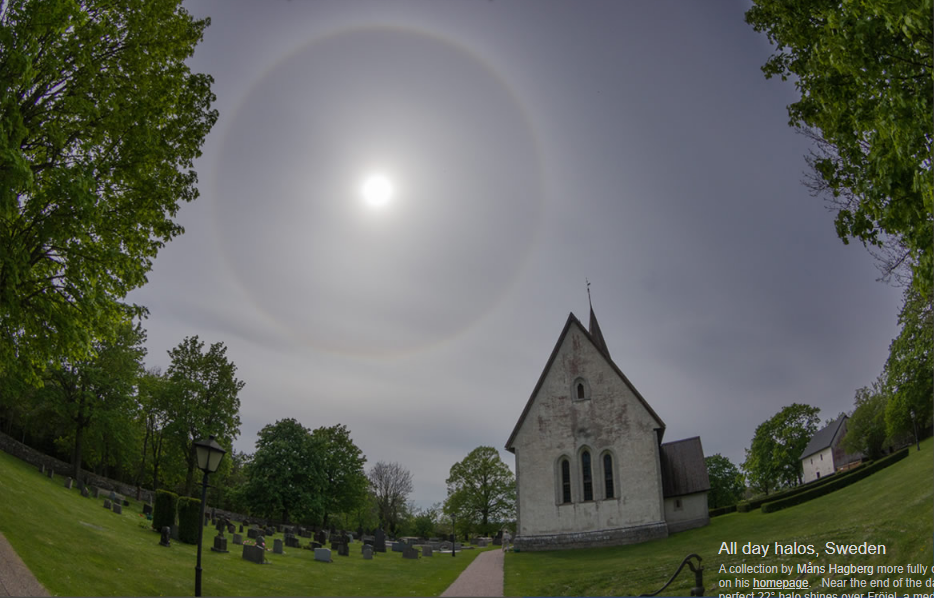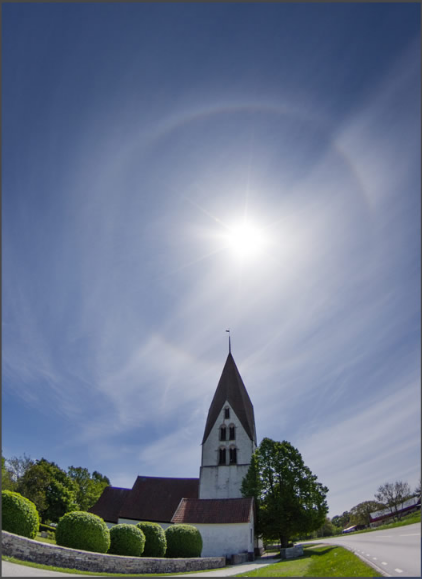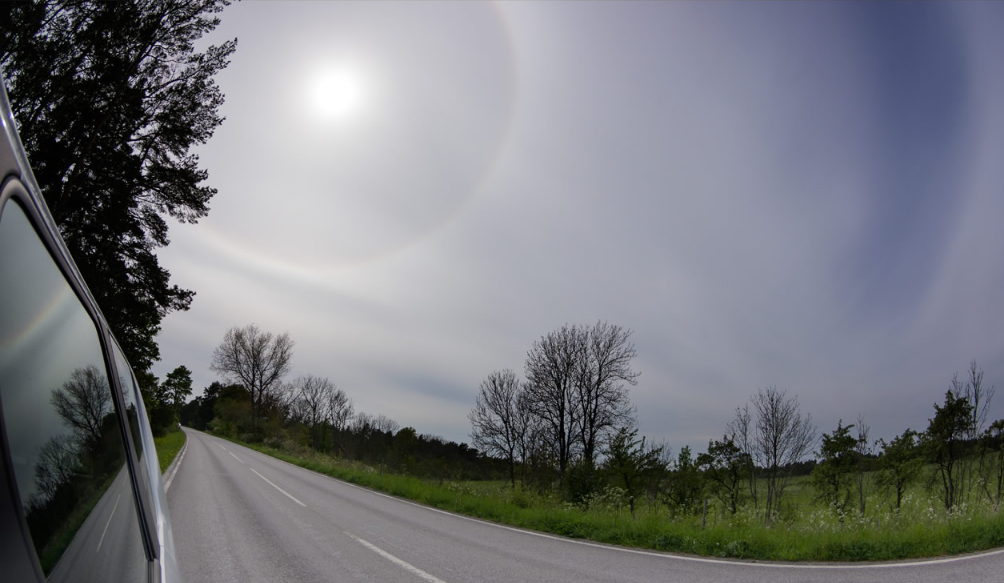Serendipitous all day halos, Sweden - OPOD
Serendipitous All Day Halos in Sweden
Have you ever witnessed a breathtaking atmospheric phenomenon that seemed to defy logic? In Sweden, a country known for its stunning landscapes and natural wonders, one photographer, Måns Hagberg, captured a series of serendipitous all day halos that left viewers in awe. These captivating images, which can be found on his homepage, showcase the beauty and complexity of atmospheric optics.
A Perfect 22° Halo at Dusk
As the day draws to a close, the sky above Fröjel, a medieval church with an intriguing heathen name, is adorned with a near perfect 22° halo. This optical phenomenon creates a luminous circle around the sun or moon, caused by the refraction and reflection of sunlight by ice crystals suspended in the atmosphere. The halo appears as a ring of light, with the inner edge touching the sun or moon and the outer edge displaying vibrant colors.
The Enigmatic Halo Over Sproge
Earlier in the day, Hagberg captured another stunning display of halos over the church of Sproge. These halos exhibited a unique characteristic – they were brighter at the top and bottom. Through color subtraction enhancement techniques, it was revealed that these halos were created by outer circumscribed halos formed by horizontal column crystals. These randomly oriented hexagonal ice prisms generate the 22° halo, creating a mesmerizing spectacle in the sky.
The Mystery of the Dark 'Hole'
One intriguing aspect of the 22° halo is the absence of rays refracting within it, leaving a dark 'hole' in the sky. This phenomenon occurs because the ice crystals that form the halo are randomly oriented and do not refract light in a way that produces visible rays. Instead, they scatter the light, resulting in a dark region within the halo. This creates a striking contrast between the luminous ring and the surrounding sky.
Tracing Rays Through Ice Crystals
To better understand the formation of these all day halos, researchers have traced rays through randomly oriented ice crystals, including horizontal columns and plates. The presence of horizontal plates explains the absence of sundogs, which are colorful patches of light that often accompany halos. Since the sun is positioned too high in the sky, the plates do not produce the necessary conditions for sundogs to form.
Ever-Changing Crystals
Ice crystals are constantly changing, leading to variations in the appearance of halos throughout the day. In one of Hagberg's images, a strong circumscribed halo fragment is visible on the left side, while a clear 22° halo is captured on the right side. These changes in crystal orientation and shape result in different patterns and intensities of halos, adding to their mystique and beauty.
Crepuscular Rays and Wind Turbines
In addition to the captivating halos, Hagberg's photographs also showcase another atmospheric phenomenon known as crepuscular rays. These rays, often referred to as "sunbeams," occur when sunlight is scattered by dust or other particles in the atmosphere, creating visible beams of light. In this case, the blades of wind turbines cast shadows that intersect with the hazy air, producing striking crepuscular rays.
The serendipitous all day halos captured by Måns Hagberg in Sweden serve as a reminder of the wonders that can be found in our own atmosphere. These ethereal displays of light and color are a testament to the intricate interplay between sunlight and ice crystals suspended in the sky. Whether it's a perfect 22° halo at dusk or ever-changing patterns throughout the day, these atmospheric optics phenomena continue to captivate and inspire us with their sheer beauty and complexity.

All day halos, Sweden
A collection by Måns Hagberg more fully documented on his homepage. Near the end of the day a near perfect 22° halo shines over Fröjel, a medieval church with a heathen name. All images ©Måns Hagberg,


Earlier in the day, halos over the church of Sproge. The circle is brighter at top and bottom. Colour subtraction enhancement reveals an outer circumscribed halo from horizontal column crystals.
Randomly oriented hexagonal ice prisms of some kind generate the 22° halo. No rays refract within it leaving a dark 'hole' in the sky.

Rays traced through randomly oriented crystals, horizontal columns and horizontal plates. The plates show no sundogs because the sun is too high.


Crystals ever change. Earlier at left a strong circumscribed halo fragment. Later at right, a clear 22° halo
Wind turbine blades cast 'crepuscular' ray shadows through hazy air.

Note: this article has been automatically converted from the old site and may not appear as intended. You can find the original article here.
Reference Atmospheric Optics
If you use any of the definitions, information, or data presented on Atmospheric Optics, please copy the link or reference below to properly credit us as the reference source. Thank you!
-
<a href="https://atoptics.co.uk/blog/serendipitous-all-day-halos-sweden-opod/">Serendipitous all day halos, Sweden - OPOD</a>
-
"Serendipitous all day halos, Sweden - OPOD". Atmospheric Optics. Accessed on November 26, 2024. https://atoptics.co.uk/blog/serendipitous-all-day-halos-sweden-opod/.
-
"Serendipitous all day halos, Sweden - OPOD". Atmospheric Optics, https://atoptics.co.uk/blog/serendipitous-all-day-halos-sweden-opod/. Accessed 26 November, 2024
-
Serendipitous all day halos, Sweden - OPOD. Atmospheric Optics. Retrieved from https://atoptics.co.uk/blog/serendipitous-all-day-halos-sweden-opod/.